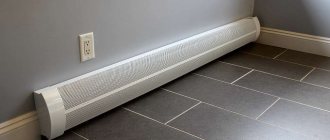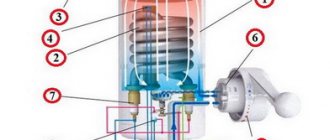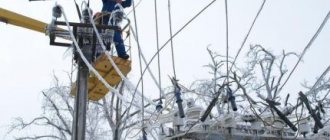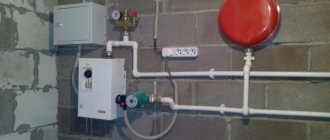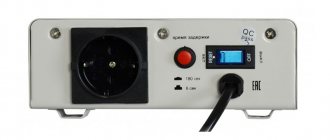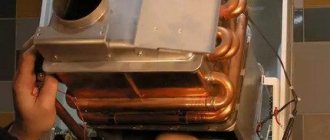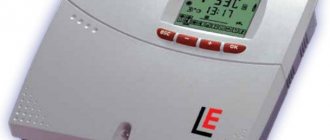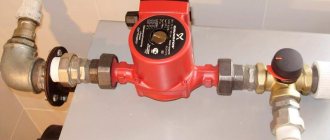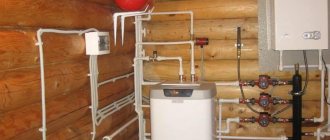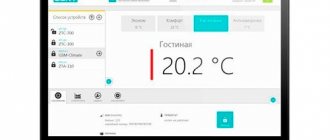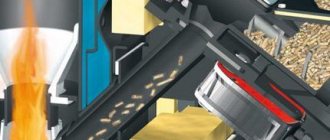Many modern heating systems are controlled automatically and require a constant supply of electricity to operate correctly. If there are regular power outages, experts recommend purchasing a backup generator. When the absence of electricity is rare and does not last long, it is enough to install a progressive inverter for the heating boiler.
It converts the direct current coming from the battery into alternating current and allows the heating equipment to fully function for a certain time even in the absence of electricity. Let's take a closer look at the main characteristics of the device.
General characteristics of the device
An inverter is primarily a DC to AC converter. In parallel, it changes the transmission amplitude and generates an output signal of a suitable frequency. The device itself cannot charge the battery and monitor its current capacity.
Many modern manufacturers equip their products with accompanying elements, additional chargers and a control control unit. Such models are already classified as uninterruptible power supplies (UPS) and have the ability to solve a wider range of problems.
Manufacturers provide a great guarantee for the uninterrupted operation of inverter equipment for boilers - from 10 to 12 years with 600-620 active cycles and battery discharge at 80-83%
Integrated into the heating system, they monitor the presence of current in the network and, in the event of a sudden emergency shutdown of the electrics, maintain full operation of the equipment for some time.
In this way, preventing potential freezing of water in pipes and radiators (in winter), breakdown of individual parts of the system and other unpleasant problems.
An inverter equipped with an additional battery allows heating equipment to operate for a long time and efficiently even in the absence of a centralized electricity supply for a long time
Simple, low-cost products perform only one direct function - providing the boiler with energy to operate for a certain amount of time. Complex progressive modules have expanded potential.
In addition to their main mission, they act as stabilizers and equalize the voltage in the system, thus protecting equipment from excess load and failure.
Organization of the heating system
Depending on the power, all inverter boilers can be divided into the following types:
- Industrial. They have large dimensions, a rather complex current conversion system (carried out by an inverter for a heating boiler), and volumetric heat exchangers.
- Household. This type of model is characterized by relatively small dimensions, as well as the ability to operate on mains power or batteries.
To organize an inverter-type heating system, you should carefully pre-design it.
When the boiler is operating, the overall load in the electrical network of the premises will increase, so the wiring will need to be laid with a larger cross-section.
An important aspect is the safety of the boiler. And this nuance must be properly ensured. So, you will need to install a protective electrical unit that will automatically de-energize the boiler if there are voltage drops in the network.
Complete set of inverter energy sources
In the modern market of household related equipment, inverters are presented in several versions. Some brands produce extremely simple units that work only as voltage converters.
The rechargeable battery is not initially included in the package of such modules, but its connection is allowed by the design, and the user can purchase this element separately in the future.
You need to purchase inverter equipment only from the regional official representative office of the manufacturer. There, in addition to the product, the buyer will be given a warranty card for service and, in case of problems identified in the first working days, the product will be replaced with a working one
Some types of inverters have a built-in battery of a certain, usually small capacity, but increasing its volume using external additional batteries is not possible.
Devices of this type keep the heating equipment operating for a short time and mostly serve to enable the owner to correctly disconnect the system from the power supply in an emergency.
A basic battery is built into universal units. Expanding the capacity of the device is carried out by adding external batteries. In this way, the operating time of the device is increased from several hours to several days.
Differences between inverters in signal form
There are many inverters on the market that differ in the form of the output voltage. It comes in the following types:
- Quadratic;
- Trapezoidal or modified sinusoidal;
- Sinusoidal.
For a gas boiler, the voltage converter must produce exclusively a sinusoidal signal. Another one, for example, intended for a computer, will not ensure its functioning at the proper level.
Recently, inverters with a sinusoidal waveform have been supplied to the market.
Product design features
The inverter has optimal dimensions and is shaped like a parallelepiped. Placed on the floor in close proximity to the boiler or mounted on the wall (if provided for by the design features of the purchased model).
The working battery transmits a direct current of 12 V. The inverter absorbs it and converts it into alternating current with a traditional voltage of 220 volts, and also monitors the state of charge of the battery itself
In advanced models, a control unit with a boiler switching system and a basic battery are located inside the housing. The first node monitors the availability of energy and promptly switches the equipment to autonomous operation if interruptions in the supply of resources occur in the central network.
The second unit (battery) provides power to all electronic elements of the boiler for the entire period of power outage or until the charge runs out.
Solar collectors
The essence of solar collectors is to collect, store and transfer heat from the sun. Solar energy can be used freely and endlessly; it does not require extraction or transportation. There are two main types of collectors - flat and vacuum.
Flat-plate collectors
Flat solar collector
The design of flat-plate solar collectors is a heat-insulated panel located under glass, inside of which there is an absorbing plate. It is she who accumulates the energy of the sun. However, even taking into account the thermal insulation of the bottom and side walls, in winter the charge level is much lower due to heat loss. Flat-plate collectors are less suitable for temperature changes, but are more widespread due to their low cost.
Vacuum manifolds
The structure of vacuum solar collectors involves several vacuum tubes converting sunlight into thermal energy. The tubes themselves are similar to a regular thermos and consist of several glass tubes built into each other. The outside of the tubes is translucent, and inside there is a material that collects sunlight.
Vacuum manifolds
Collectors are located on the roof and/or walls of the house. Vacuum solar collectors are much better protected from temperature changes and absorb heat better, which is why they are suitable for operation in cold weather.
How are devices classified?
Almost all inverter devices are components of a UPS (uninterruptible power supply) and perform the same function - convert direct current from the battery into alternating current.
In the event of an unexpected power outage, the backup power supply system is activated, and the heating equipment instantly switches to autonomous operation. This allows you to maintain the full functioning of the heating over a certain period of time - from several hours to several days.
According to the operating principle, the devices are divided into three types:
- Off-line (backup);
- Line-interactive (line-interactive);
- On-line (double conversion).
Each type of device has its own specific characteristics and capabilities that allow it to solve diverse problems. After thoroughly studying the parameters of all three devices, choosing the best option for yourself will not be difficult.
Operating principle of Off-line units
The off-line model has a simple design and is considered a backup model. When the electrical network operates in standard mode and demonstrates stability, and the voltage does not “jump” between extreme values, the device “sleeps” and does not participate in the operation of the household heating system.
If the current level drops to 175 V, the unit switches the heating boiler to recharge from the battery. As soon as the situation is restored, the inverter UPS reconnects the heating equipment back to the main network.
The off-line device is ideal for working in conjunction with a gas heating boiler, but only if there are no problems with voltage stabilization in the central power grid
Each transition from the main power source to an autonomous one and back lasts no more than 10-15 seconds and does not in any way affect the functionality of the heating equipment.
The operating range of most off-line converters lies in the range of 170-270 V.
Progressive inverter converters are usually equipped with informational liquid crystal displays and current regulators. They do not have an active cooling system. Due to this, the work process is absolutely silent and does not disturb residents with annoying sounds.
With a constantly “jumping” voltage, switching from the main system to the autonomous system occurs too often and leads to rapid wear of the batteries and the device itself. Stabilizers are not included in the device, so when connected, both at the input and output, the mains voltage does not change.
Therefore, we recommend reading our article on how to choose a voltage stabilizer for a heating boiler. Read on for more details.
Depending on the manufacturer and model, backup appliances can effectively handle electrical equipment ranging from 300 to 3,500 watts. Some products provide cyclic operation and the ability to prevent communication parts of the heating system from freezing for a day or more.
How do Line-interactive modules behave?
The Line-interactive device is a switching type device and is considered the best option for universal equipment. Structurally, the product consists of an off-line source, a converter, a switching relay and a low-frequency stabilizer device.
In the standard operating mode of the unit, the heating equipment consumes the resource of the central energy main. The output voltage is controlled by a stabilizer and special filters (for some models), smoothing out noise and neutralizing interference from the network to which the boiler itself is connected.
A gas boiler connected to a line-interactive converter equipped with an additional external battery can operate from 8 to 10 hours (depending on battery capacity)
Line-interactive type units supply electrical appliances with useful energy for a very short period of time (no more than 20 minutes).
To provide heating boilers with a resource, they use not ordinary liners, but improved products with an expansion function, which provide for the connection of an additional external battery. Such devices can keep the boiler operating for a longer time (up to 10 hours depending on the manufacturer).
The line-interactive converter brings the battery into operation extremely quickly (approximately 2-4 seconds). The output flow of the device can be pulsed or sinusoidal. Experts recommend installing the second option on heating boilers
The built-in current stabilizer allows the equipment to operate correctly without switching to a battery over an extended voltage range. The device provides backup power from the battery and equalizes the mains voltage. The disadvantages of the products include the inability to correct the flow frequency of the current and minimal smoothing of the sinusoid (no more than 20%).
Features of on-line devices
Online devices operate in constant mode.
The conventional diagram for connecting heating equipment in this embodiment is constructed in the following sequence:
- central electrical network;
- inverter uninterruptible power supply;
- boiler.
The principle of operation of the device comes down to repeated transformation of the general parameters of the electrical network. At the first stage, when entering the inverter, the alternating voltage is converted into a stable equivalent with an indicator of 12 V.
Then the reverse maneuver occurs and at the output of the inverter apparatus the voltage turns into alternating voltage with a value of 220 V.
In online systems, the battery performs a buffer function and is constantly being recharged. In parallel, the output converter is activated inside the battery and forms an alternating voltage from a direct voltage with indicators of 220 V 50 Hz, no longer depending in any way on the voltage generated at the input
The main advantage of a system of this type is the provision of high-quality voltage to the power supply unit of the heating boiler. There are only two disadvantages: the high cost of conversion equipment and the low level of performance.
Customer Reviews
Alexander E.
Interactive UPS Energy Garant 500
The percentage of error in the stabilized output voltage is a little high, but this is stated in the technical specifications. It is quite good for power supply of household devices. The battery charges without overcharging and switches to inverter mode without interrupting the voltage supply to the load. Nothing gets hot, the coolers are not noisy.
Egor Stepanov
UPS RESANTA UBP-1000
This device is equipped with an electronic stabilization system. Therefore, here the relays do not click to switch windings. Accordingly, the output is a cleaner and smoother sinusoid. For measuring equipment, this operating mode is especially important. Although the output power is not high, it is quite enough for our equipment. I was looking for an uninterruptible power supply and ended up in this store, and I’m glad I found it. I chose an uninterruptible power supply (at first it was different, in consultation with the manager I settled on this model, special thanks to the seller, a person who knows his product), completed the purchase, within half an hour a very friendly manager of the online store contacted me to confirm the order and discuss the method of delivery and payment . The goods were delivered the next day safe and sound. Delivery works with a bang, I was also pleased with the payment after receiving the goods by the courier. I will be visiting this store in the future
aleksei suskan
Hiden Control HPS20-0312
I really liked the device. I am writing a review after three months. It is powered by a Protherm 40 Klo gas boiler and two circulation pumps. It switches to the battery instantly, nothing even happens to the boiler. The display is informative. Quiet. The fan does not drum. The battery charges 10 amperes, which is good since for some batteries this is the minimum value. Works with AGM 100A/h. In general, I'm satisfied.
Vladimir Ch.
SVEN RT-500
The device itself attracted me with its price and characteristics. chased the cheapness. It would be better to overpay and take something else. I unpacked it for the first time, read the instructions for gifted people, plugged it into the network and there was no signal, it turned on and went out. I'm going to service. strange things started happening there, such as we can’t accept a case not covered by warranty. he had a melted network cable. Yes, and when I turned it on, I wasn’t convinced that I had taken the pig in a poke. Well, naturally the gimmick began to spin, saying it was your fault. I’m on mine, and a koekaker from the service department named Ilya is on mine, if he’s reading this truthful review now. draw the right conclusion Ilya. so as not to lose clients from your office called slay.ru, in the end, I returned this miracle device to them after some more time of proof that it was not my fault that the device was complete G.
Larisa M.
BASTION Teplocom-1000
We installed a boiler to heat a country house, and bought this device to go with it. The voltage in the network fluctuates, especially noticeably in the evenings - there’s no way without a stabilizer, and a UPS won’t hurt. The installer promised that the boiler would operate for three hours without recharging using the UPS. I didn’t lie, they checked. When you know for sure that you will not be left without heat in the event of a power outage, it’s calmer. The device has been in service for a year and a half without any complaints. I believe that during this time he has already managed to earn back every ruble spent on him. It does not take up much space, does not overheat and is not very noisy. It charges itself from the network.
Di
Stark Country 1000 Online
After two months of operation it burned out and stopped switching modes. When opened, it turned out that the gearbox had burned out. Attached photo. Unfortunately, I didn’t take a photo from the back of the board; it looks much worse there. Traces of melting there are more extensive. Also depressing is the fact that there are burn marks on the side cover of the case. There is no insulation in areas adjacent to the body. In general, I’m extremely surprised to see something like this in a breaker/stabilizer, as if the appropriate fuses were not provided. I consider this effect of the operation of such devices unacceptable. The included batteries were Delta gel ones. The kit was used for the Wissman Vitodens 200 gas boiler.
Semyon R.
IPPON Back Power Pro II Euro 650
With an overload of 110% and up to this figure: it will work for five minutes on mains power, and five seconds on battery power. If an overload of more than 120% is allowed, it will immediately shut down. Control of input and output voltage. UPS loading control and battery condition monitoring. All this information is displayed on the screen. Fully loaded. Almost. A 350-watt computer at its peak load. And - when switching to battery power, 1 minute of battery life. Not a little. The price tag suits me, there is passive cooling in the case. Under load and simultaneous operation from batteries, the temperature is ok. Both sockets are deep, with diagonal connection of equipment (L-shaped plugs will fit in without problems). Normas.
Gleb K.
APC by Schneider Electric Smart-UPS SMT1500I
I bought it for home to power video surveillance, but also connected a PC, TV, NAS. As a result, when devices operate simultaneously, there is practically no power reserve; it was necessary to consider older models. I inserted a monitoring network card into the UPS (purchased separately). The Synology NAS connected to the UPS without any problems and began shutting down processes when switching to batteries. It sits in the closet, doesn’t heat up, but something “gurgles” inside every ~10 seconds. When I stood under the table, this sound was a little annoying. In the network card settings, I turned off the squeak from switching to batteries, and configured sending notifications to personal email. At work we also use APC UPS, but mainly of the rack type, they usually last about 10 years, I expect the same result from the new model.
Vyacheslav K.
Interactive UPS Powercom RAPTOR RPT-2000AP
Advantages: + inside there are 2 batteries to increase power and increase operating time + turns off on its own after the power is turned off and you turn off the computer + There is a voltage stabilizer, although simple, it is there, keeps the voltage from 200 to 230 at the output when the input is from 170 to 260 (lower down by 30 volts or increase up by 30 volts). Disadvantages: - the heatsinks on the board get very hot, the first UPS (the same one) burned out because of this, the board was replaced under warranty and I now installed an additional constant fan for airflow. — the original fan only works if it is running on battery power or there is a heavy load on the UPS, because of this the board overheats and we had to install an extra fan. — the battery is constantly not recharged due to low voltage at the terminals, approximately 26 volts at the terminals constantly, this is approximately 13 volts per battery. The batteries are charged to approximately 40-50%, not higher. To charge normally you need to supply 14 volts. As soon as the mains voltage disappears, after 5 seconds the battery charge drops to 40-50%, this can be seen from the installed software on the computer. - there is no declared 2000 VA, this is a marketing ploy. It holds the 5 min maximum of a simple PC with a consumption of 200 VA. Although the box says it should last up to 30 minutes. It doesn't hold up well precisely because of the inability to charge the battery completely. — the built-in cooler for cooling is bad, it is crooked and has terrible beating when rotating. — the power button is crooked, the contact in it is bad and buggy. To turn the UPS button on and off, you need to hold it for a few seconds, because... bad contact switching on switching off is buggy and goes to the test itself. Test itself with a short press of the button. — the batteries are located right next to a hot transformer, if you don’t put a gasket so that the batteries don’t get hot, then they will fail ahead of time. Comment: General impression: At the time of purchase, there was nothing better in terms of characteristics; in principle, the computer, which consumes approximately 200 VA of power, copes with its task for about 5 minutes. I basically have enough time to turn off the computer. The funny thing is that they don’t fully charge the battery, they did it this way specifically to extend the life of these batteries. If you plan to buy, open the case and place a gasket between the batteries and the transformer, and also an additional fan so that the board does not die from overheating.
Anton A.
BASTION Teplocom-1000
Advantages: Complete absence of any consequences for consumer devices from turning off the electricity. It all depends only on the capacity of the battery that you pair with the UPS. The output voltage fluctuates in the range of 220-221V (measured with a conventional tester). Disadvantages: There are not enough two pairs of battery terminals to connect everything right away. I had to go to the market separately. This shortcoming was voiced by the Deputy. Those. Directors, because It’s not good for a device that costs 20 kilo rubles to chase its owner after every little thing. All other wires and small items are present. The metal case, the design of which has probably not changed for 30 years, evokes an unhealthy nostalgia for the USSR, but in fairness it must be admitted that this is not the main thing and does not affect the functionality. Comment: I checked for a blackout in the network - as expected, I was glad to see that the light didn’t even blink. As a result, having selected a pair of batteries, the capacity of which will be sufficient for uninterrupted operation for a time equal to the average power outage interval in your region, you solve for yourself all the hemorrhoids with the operation of modern gas boilers and pumps for them. The old school of the Soviet defense industry knows a lot about serious equipment)
Advantages and disadvantages of equipment
The inverter is convenient because it is not tied to a specific type of DC voltage source. The unit can be powered using a regular car battery, a generator set with a simple signal rectification principle, or from UPS batteries.
If the module does not have a built-in charger, the owners will have to personally control the capacity level and the degree of discharge of the device.
Among the main advantages of the device:
- a wide range of models and the ability to select a product with an almost ideal output sinusoid;
- correct operation with all sources of rated voltage and direct current;
- reasonable cost compared to other similar units of similar power;
- no restrictions on increasing battery capacity and duration of autonomous operation.
Disadvantages include criteria such as:
- lack of control over the battery charging/discharging level;
- the response threshold setting is not subject to additional correction;
- the need to arrange an external communication circuit for automatic activation in the event of a power outage in a residential area;
- high cost of “sophisticated” modules with a wide range of capabilities.
The final choice of a suitable device is strictly individual. It all depends on how much the voltage “jumps” in the network, how often consumers are cut off from the supply of resources by the central electrical system, and how long they have to sit without electricity.
Operating rules
In order for the device to serve for a long time, it is necessary to adhere to certain rules during operation:
- The distance from the heater to any object must be at least 500 mm.
- The unit cannot be placed under a window opening.
- Experts do not recommend leaving the device turned on overnight; this can only be done if there is a thermostat inside it that regulates the frequency of operation.
- You should not dry things on a heater.
Energy efficiency is now considered one of the most important criteria when choosing heating devices, so you should carefully approach the purchase of heaters. Unlike convective heating (central heating, oil radiators), inverter devices allow you to warm up that part of the air mass where people are, which is very convenient and profitable.
Basic rules for choosing a module
When planning to purchase an inverter for a boiler, you need to pay close attention to such parameters as:
- indicator of input voltage and current;
- output voltage level;
- degree of distortion of the output voltage sinusoid;
- actual conversion factor;
- total power output.
For domestic gas boilers, inverter units 12-220 are mainly used. These units convert 12V DC battery voltage into 220V sine wave voltage with minimal distortion.
The sine wave of the inverter output voltage should not exceed 3%. These indicators mean that the signal shape is as close as possible to a sine wave with minor deviations towards a sharp decline or cut off peaks
You can also acquire a more powerful combination of units (24-220 converter and 24 V battery), but you need to find out exactly what maximum input current the inverter is designed for.
Only after receiving this information should you start purchasing.
Inverters offered on the domestic market are initially designed for low quality electrical networks. The units have all the functions of protection against energy surges and an option that allows the user to set upper and lower voltage limits down to volts
The controller and control unit of popular gas boilers usually consume power of about 150-200 W. Responsible for the correct circulation of the heating fluid in the system, the circulation pump takes another 125-150 W. To determine the required power of the inverter, these data must be added and multiplied by 2.5 to take into account the volume of starting current at the time of startup.
The finished numbers must be multiplied by 1.2 again to take into account some power reserve. Remember or write down the received data. When purchasing an inverter, make sure that the base power declared by the manufacturer certainly exceeds the calculated values.
Uninterrupted power supply to boilers - how long is required?
To choose a boiler backup power supply, you must first ask yourself the question for how long you need to reserve electricity. The most common situations in which uninterrupted power supply to boilers is required are the following:
- Constant short-term power outages associated with exceeding consumption limits or worn-out networks. Duration – 0.5 – 2 hours.
- Short-term power outages while work is being carried out to connect new subscribers, while fuse links are being replaced at transformer substations, and during the elimination of minor accidents. Duration – 3-6 hours.
- Short-term power outages in the event of an emergency shutdown of the system due to short circuits, in case of malfunctions in the transformer substation. If the team leaves regularly and quickly, the city is nearby. Duration – 12-24 hours.
- Possible emergency situations associated with difficult weather conditions or the inability of emergency teams to quickly respond. Duration – 1-3 days.
To understand which power source for the boiler will be optimal, you should estimate the best option for each of these situations, and then choose for yourself how to implement it.
List of popular models and manufacturers
There are many domestic and foreign companies, firms and organizations operating in the electrical engineering market segment. Some of them produce products under license, others develop their own technologies and offer customers unique, innovative and competitive products at a very reasonable price.
Device
Inverter Energy PN-500 is an inexpensive, practical device that provides uninterrupted power supply for modern low-power boilers. Manufactured at the production facilities of ETK Energia, one of the leaders in the domestic electrical market.
ETK Energia inverters fully comply with all GOST standards and requirements for household electrical equipment. The environmental safety and quality of products are confirmed by international certification certificates issued to the company.
Connecting one basic battery to the device ensures full autonomous operation of the fuel boiler for 6-7 hours. If you connect a second battery, the operating time will double.
The unit produces a pure sine wave at the output, which helps preserve the expensive electronic “filling” of modern heating boilers. When the operation of the central electrical system returns to normal, the inverter automatically switches to voltage stabilization mode and protects the boiler from sudden power surges.
Device "Elim-Ukraine"
has been operating in the electrical equipment market for more than 10 years and is respected by customers.
Devices produced under this brand have a switching power supply, eye-pleasing LED display and demonstrate an extremely high level of efficiency (up to 98%). Produces a pure sine wave signal without distortion or surge levels.
Inverters are also convenient because they work correctly with both gel and car batteries
Equipped with protection against overheating, general overload and deep battery discharge. One of the expansion options allows you to connect an additional battery of any capacity to the equipment to maintain autonomous operation of the heating system even in the absence of voltage in the central main networks for a day or more.
Unit Rucelf UPI-400-12-EL
The Rucelf UPI-400-12-EL device belongs to the category of linear-interactive energy sources. It has a built-in stabilizer, which, even if there is a minimum mains voltage, equalizes the current flow without using the battery. This makes it possible to economically use the battery life without overloading and extending their service life.
Important advantages of Rucelf UPI are completely silent operation and efficient provision of devices with the necessary power supply during a power outage
Reasonable cost is another characteristic feature of the products of the Russian company Rucelf.
Thanks to this, customers can create a full-fledged autonomous infrastructure to recharge heating systems during emergency power outages or power surges.
Pivot table
In the following table you can get acquainted with 9 popular and efficient UPSs on the market, which are divided into 3 subgroups. From the names you can understand that the main factor is the required uptime.
We also took into account the heated area of the house: the larger it is, the higher the power consumption of the boiler and pumps.
Each subgroup presents models for houses up to 100 sq.m (power consumption of boilers and pumps - 100-150 and 30-50 W) and for 100-200 sq.m. (150-200 and 60-100 W). 9 best UPS for gas boilers
| Group 1: UPS for short (up to 2 hours) and rare (2-4 times a year) outages | ||
| 1. IBPS-12-300N |
Ideal for: a boiler in a small house up to 100 sq.m with a stable voltage of 220 V | 11000₽ |
| 2. Energy UPS Pro 500 12V |
Ideal for: boilers without external circulation pumps in a small house up to 100 sq.m. | 10800₽ |
| 3. Energy Guarantor 1000 |
Ideal for: connecting boilers and pumps in houses of 100-200 sq.m. | 12900₽ |
| Group 2: UPS for long-term (from 2 hours) and frequent (from 5 times a year) outages | ||
| 4. Energy UPS Pro 1000 12 V |
Ideal for: sensitive boilers and pumps in houses of 100-200 sq.m. with unstable voltage | 16800₽ |
| 5. Energy PN-1000 |
Ideal for: boilers and pumps in houses of 100-200 sq.m with stable voltage | 12900₽ |
| 6. ELTENA (INELT) Intelligent 500LT2 |
Ideal for: boilers with built-in pump in houses up to 100 sq.m. | 10325₽ |
| UPS for combined operation with an electricity generator | ||
| 7. Helior Sigma 1 KSL-12V |
Ideal for: uninterruptible power supply to boilers and pumps with unstable voltage | 19350₽ |
| 8. P-Com Pro 1H |
Ideal for: boilers with ultra-low voltage and high noise requirements | 17700₽ |
| 9. ELTENA (INELT) Monolith E1000LT-12V |
Ideal for: expensive boilers with sensitive electronics | 21600₽ |
Now let’s take a closer look at the characteristics of the models, study customer reviews and watch video reviews.
